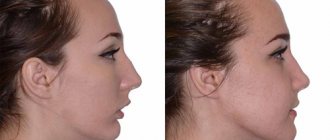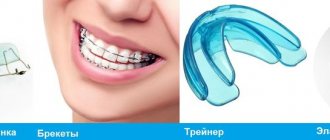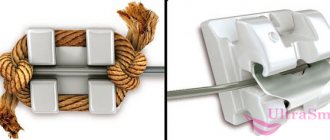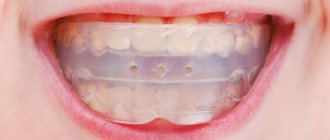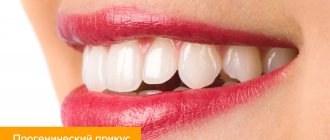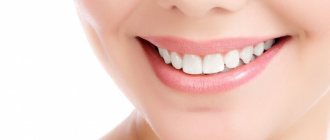Mouth guards for correcting bites are a high-tech product that helps correct bites effectively, comfortably, and without unnecessarily attracting the attention of others to the treatment. Since the mouth guards are made using computer calculations, many people think that the doctor’s participation in the process of correcting the bite with mouth guards is minimal, because everything is calculated by the computer, and all that remains is to change the mouth guards according to the treatment plan so that the teeth become straight. This is wrong. To dispel the myths that have developed around correcting bites with mouthguards, we asked Oksana Igorevna Bolshova, an orthodontist at the Family Dental Clinic, to answer the main questions. Oksana Igorevna has extensive experience in using mouth guards from different manufacturers.
Mouth guards as an alternative to braces
Straightening crooked teeth, of course, should be done in childhood. However, many parents simply do not pay attention to this problem. Therefore, the question of orthodontic treatment for most patients arises in adolescence or adulthood. However, not every teenager or adult will agree to put braces on their teeth and follow not the most simple rules of hygiene. Until recently, there was no alternative to braces. But with the advent of aligners - mouth guards for straightening teeth, it became possible to undergo orthodontic treatment unnoticed by others and with comfort for yourself. Moreover, this applies not only to adults, but also to teenagers, for whom their own technology of transparent mouth guards has been developed. Like aligners for adults, they are a set of removable aligners, completely invisible to others, which can correct most dental anomalies, provided that the attending physician has the appropriate experience.
What parents need to pay attention to
Ages 3 to 6 years
It is necessary to pay attention to early signs that contribute to the occurrence of improper development of teeth and dentition.
Let us list the points that help a child’s teeth grow crooked:
- early loss of baby teeth,
- breathing disorders,
- closing of the child's lips during sleep,
- sluggish, slow chewing and swallowing,
- speech disorders,
- poor posture,
- bad habits - sucking fingers, tongue, objects.
When studying the survey data, it was revealed that the majority of patients (95%
) were referred to an orthodontist after 6 years.
I don’t doubt for a second that if you knew that your child could develop a malocclusion, you would immediately begin to follow the doctor’s advice: change your diet, eliminate bad habits, and perform therapeutic exercises. This relates to the question of how early you should see an orthodontist.
Why do something now, when it’s already clear that “the teeth are crooked, when they grow, then we’ll put braces on him”
In the modern world, orthodontics plays a huge role. The desire for a beautiful, even smile, the desire to have snow-white, straight teeth becomes the norm of life. Thus, it is obvious that by referring children in early childhood to an orthodontist, who can give professional advice on the prevention of dental anomalies, it is possible to prevent the formation of malocclusion in children. And avoid dental problems in adulthood.
My doctoral daily practice in communicating with children and parents shows a fairly good awareness of orthodontic treatment methods. About the existence of dental plates and braces
, we don’t have to talk about trainers for a long time - these types of orthodontic structures are the most common, widely known to both the small and adult population.
Early treatment takes advantage of progressive, irreversible tissue changes during tooth growth and eruption, targeting them to stop the development of the anomaly before significant dental and morphological compensation occurs.
The main task facing the orthodontist is the following: it is necessary to give the teeth the correct vector of development
, create conditions around the teeth for their optimal growth!
Dear friends, in early childhood, the orthodontist, together with the parents, is the coordinator of the correction of dental anomalies that form during the period of active growth of the child’s teeth. The consequences of inaction - that is, waiting until the child grows up and you install permanent braces or any other aggressive devices - are more difficult to treat and retain, and maintain the achieved result.
By using early orthodontic treatment, you and I have the unique ability to manage tooth eruption to minimize the need for future tooth movement.
Why are records needed?
Most practicing orthodontists find it difficult to determine exactly when it is worth interfering with the formation of malocclusion, and when Nature should still “do its thing.” This is because experience only comes after years of careful observation, and the decision to intervene is often driven by parental demands to “do something.”
Orthodontic care for a child consists of the use of preventive and therapeutic measures - myogymnastics, hardware and surgical treatment. The most common of them is the hardware method.
A dental plate is a passive removable orthodontic device, and if a screw or various spring elements are added, the design becomes an orthodontic device with active mechanical action. The activity and strength of the device depends on how many millimeters the doctor has extended and activated the spring, tightened the screw, etc. The fulcrum in them is the teeth and the alveolar process under the base, the regulating active part is a screw, a spring, and the clasp is a fixing part.
How to sleep with dental plaques, will my child swallow them at night while sleeping?
There is no reason to panic, dear friends, the orthodontic device (plate) in the correct individual high-quality production is sufficiently tightly fixed due to the hooking metal elements, as well as the anatomical shape.
When putting on the dental plate, you can hear a characteristic click - this is a positive thing. It is very important to properly remove and put the plates on your child’s teeth so as not to bend their wire elements, and also carefully monitor their cleanliness and maintain hygiene.
Features of a mouth guard for teeth straightening
Removable aligners for teeth straightening for adults are made from a special transparent material. Today, their range of applications is no different from the capabilities of braces, but treatment with mouth guards is much easier and more enjoyable. The main advantage of the system is that they are not visible, whereas braces, whether sapphire or ceramic, are still visible on the teeth. Of course, there are also lingual invisible braces, which are attached to the teeth from the inside, but they have a fairly long period of adaptation, just like other brace systems. Typically, it takes several weeks for the patient to adapt to braces, during which it will be uncomfortable for the wearer to eat and talk. In addition, braces, like other types of mouth guards, rub the mucous membrane and “scratch” the teeth, which causes some discomfort. But correcting a bite with a mouth guard is as comfortable as possible for patients.
What is better for correcting a bite - mouthguards or braces, which is more effective?
Both mouthguards for correcting bites and braces are only a tool in the hands of a doctor. Have you ever held an excellent tool in your hands that you don't know how to use? Didn't you find the tool useful? The same goes for braces and mouth guards.
Bite problems can be corrected with both braces and mouth guards, and sometimes even more can be done with mouth guards. It is important to consider how the doctor can work better, what tools work easily, and what method of treatment will be more comfortable for you.
To make this easier to understand, imagine how different your favorite musical composition will sound if performed by an amateur or by a talented musician. Someone will play the same piece using three chords, and someone will perform the melody in such a way that it will be unforgettable and will fill your soul with pleasant, joyful feelings for a long time.
Transparent mouth guard for teeth straightening and trainers
Dental aligners for straightening teeth are often confused with trainers and retainers, which are worn after braces are removed. Meanwhile, these are completely different orthodontic devices, which have different indications for use and have different effects on the dental system. Trainers are somewhat reminiscent of sports mouthguards to protect teeth from impacts. With their help, it is possible to correct malocclusion and dental position in children from three years of age, which have developed as a result of impaired breathing and swallowing functions, as well as due to numerous childhood bad habits, such as prolonged sucking of a pacifier or bottle. Trainers are particularly effective for treating early stage malocclusions and are therefore mainly suitable for children under 11 years of age. A retainer is usually prescribed to consolidate the results of orthodontic treatment and adjust muscle function in accordance with the bite. It is bulkier than a clear aligner for adults and is made of flexible silicone.
Manufacturing process and treatment features
First of all, the patient goes for a personal consultation with his doctor. He must also undergo a complete sanitation of the oral cavity, heal all existing carious cavities and eliminate inflammation.
Only after this does the specialist begin making the mouthguard itself:
- An impression is made of the patient's jaw, from which the doctor can recreate a plaster model of the jaw.
- Next, a 3D model of the correct position of the teeth is created, which the doctor will strive for.
- If the patient is satisfied with everything, you can move on to the next stage.
- It is important to know that the course of treatment requires up to 25 drops. All of them have a specific numbering and must be used sequentially one after another.
Capabilities of the mouthguard
The mouth guard will help cope with the following ailments and abnormalities:
- Very large gaps between the teeth or, conversely, excessive crowding in the row.
- Minor malocclusion.
- A noticeably prominent arrangement of one or more teeth relative to others.
- Loss of teeth due to injury and, as a result, malocclusion.
In addition, mouthguards are often used in childhood, when there is improper eruption of the first and molar teeth.
Mouth guards or braces
First of all, it is worth noting that braces systems will cost the patient much less than mouth guards. However, before making a choice, you should consider several points and understand the differences between these two methods.
Braces are made of durable metal or equally durable ceramics, and mouthguards are made of plastic. As a result of wearing braces, soft tissues may be injured, and the enamel may change its shade. Mouthguards are absolutely safe and non-traumatic.
Advantages of the mouth guard:
- The design is removable, which allows you to clean your teeth and the product itself more thoroughly. This reduces the risk of developing caries.
- Custom-made mouthguard simplifies the installation process. Braces made to certain standards are not suitable for everyone.
- Mouthguards are not noticeable to others.
Despite many advantages, mouthguards, unfortunately, cannot cope with very complex pathologies.
Silicone aligners for teeth straightening
Treatment with clear aligners minimizes the risk of medical error. The fact is that while wearing braces, the dentist takes a very active part and is independently involved in their installation and corrections, and in the process he may make a mistake. As a result, the course of treatment and, as a consequence, its outcome may be disrupted. In addition, during the next correction, there is a risk of “tightening” the ligature, which can cause severe pain and “eversion” of the roots of the teeth. A transparent mouthguard for straightening teeth for adults acts on hard tissues very smoothly and, if the doctor initially correctly calculated the trajectory of teeth movement, cannot disrupt the course of treatment.
Indications for use
Aligners are universal orthodontic systems that can cope with a variety of problems. They are prescribed for the following indications:
- trema and diastema;
- distal bite, when the lower jaw occupies a posterior position in relation to the upper jaw;
- crowded teeth;
- crossbite – when the lower jaw overlaps the upper jaw;
- protruding teeth – if one dental arch is pushed forward;
- open bite – lack of closure of the lateral or front teeth;
- direct bite, in which the maxillary and mandibular rows of teeth are closed by the cutting edges of the incisors;
- mesial bite - when the lower jaw protrudes forward.
In many clinical cases, mouthguards can achieve high-quality and reliable results faster than braces. Treatment with aligners takes from three months to one and a half to two years. In the case of braces, this period ranges from six months to three years or more.
The exact time depends on the complexity of the case and how responsibly the patient follows the rules and recommendations.
The impact of the aligners begins immediately after they are placed on the teeth. The first results can be seen within a month.
Mouthguards are suitable for the correction of dental anomalies in adults and adolescents after complete replacement of milk teeth with permanent ones.
Plastic mouth guards for straightening teeth in teenagers
Despite all the advantages of plastic mouthguards, many people consider removable designs inappropriate for teenagers. The biggest concern of orthodontists and parents regarding orthodontic treatment with aligners is that the patient will constantly remove the appliance, and the entire treatment will go down the drain. The fact is that to achieve the desired effect, the structure must be on the teeth for at least 20 - 22 hours a day. Not all adults follow this immutable rule, let alone teenagers. For peace of mind, you can choose removable mouth guards for straightening teeth in teenagers with an indicator that changes color depending on how many hours the patient has been wearing it. If a teenager has worn a mouthguard too little, the indicator will show this.
Advantages and disadvantages of technology
Among the important advantages of the technology are the following:
- Comfortable to wear. Children usually quickly get used to this need.
- Harmlessness. By using high-quality materials, you will not damage your teeth or gums.
- Easy to care for. The mouth guard will only need to be cleaned periodically.
- Noticeable result. The bite is truly corrected, and it helps many children avoid the much more difficult wearing of braces.
- Possibility to remove the mouthguard. This allows you not to limit yourself in the foods you eat and brush your teeth normally.
At the same time, the child will not have to worry about his diction being impaired - the mouthguard can be worn at night or when he is at home. The technique differs favorably from braces in its ease of care and significantly lower likelihood of oral diseases. The production uses completely safe materials that do not cause allergies.
But it is worth remembering the disadvantages. So the price of a mouthguard for a child may seem high to many. This option is not suitable for everyone. For example, if the baby has complex defects, they will have to be corrected in other ways.
Night guard for straightening teeth
Imagine that there is a design for correcting your bite, which you only need to wear at night. It does not require any additional care other than simple cleaning once a day. Thus, it does not interfere with work, communication, eating and does not cause discomfort. Intrigued? We hasten to disappoint you. Unfortunately, nothing like this has yet been invented. But it’s hard not to agree that if a night guard existed, it would, without a doubt, be considered the most convenient to use and enjoy overwhelming success. However, correction of dental anomalies is a complex process that involves exposure to teeth over a certain period of time, and wearing aligners for less than 20 hours a day, unfortunately, will not be effective.
However, among the arsenal of orthodontic devices there are still devices that need to be worn only at night. They are called removable retainers and are used to consolidate the results after treatment with braces. The teeth do not immediately “get used” to the new position, so they often strive to return to their original position. Retainers prevent them from doing this and help keep their teeth perfectly straight.
How is an orthodontic mouth guard installed?
The removable retainer is placed by the orthodontist for the first time; in the future, this can be done by the patient himself. Before the first installation, the doctor prepares the oral cavity for the installation of an orthodontic structure. Checks that the braces system does not damage tooth enamel, evaluates the presence of carious lesions, and covers the teeth with a special protective layer.
A custom-made or thermally modeled mouth guard is placed on the patient's teeth and shown how to remove and put it on independently.
Installing a mouthguard to straighten teeth
Aligners are much easier to install than braces, and they are also much more comfortable to wear and adjust. This procedure usually takes place in 3 stages.
- Diagnostics.
The doctor examines the patient for contraindications and diseases that must be eliminated before starting treatment. An accurate cast of the jaw is then made, which will serve as the basis for creating the mouthguards. - Manufacturing.
All data - x-ray, tomogram, jaw model - are sent to the company’s laboratory and processed in a special program. After this, a special device produces the required number of aligners to straighten the teeth. - Installation.
A person receives a set of products and recommendations for use. The specialist helps you put on the device, prescribes medications if necessary, and then sets a date for the next appointment. You will have to visit the orthodontist only once every one and a half to two months to monitor changes. The aligners do not require correction; the dentition is corrected by changing the set every two weeks.
How to correct a bite in children using mouth guards (aligners)
The orthodontist takes impressions of the child’s teeth using silicone mass and special baby spoons. The technology for taking impressions for children's mouthguards has its own characteristics that take into account the mechanics of the movement of children's teeth. It is also possible to take digital impressions of teeth (dental scanning) - without silicone mass. Based on the impressions taken and diagnostic results, the orthodontist uses a computer program to create a treatment model in the form of a three-dimensional image (setup) - intermediate stages and the final result of treatment are simulated. If the patient’s parents agree with the presented model, the order is transferred to production and the required number of mouth guards is produced.
Each stage of treatment with children's aligners lasts longer than for adults. One stage (step) consists of 3 aligners, made according to the same model, but differing in thickness. The first aligner (its thickness is 0.5 mm) in a step should prepare the tooth for movement. The second aligner (0.65 mm thick) moves the tooth. The third aligner (0.75 mm thick) secures the result.
Each aligner must be worn for 10 days. It turns out that one stage takes a month, and not two weeks, as in adults.
Does a mouthguard help straighten teeth?
The principle of operation of aligners is almost the same as that of braces - moving teeth into the correct position by applying pressure to them, but the impact of aligners is much gentler. An additional advantage is that this orthodontic design does not require correction; alignment occurs by changing sets.
In general, the effectiveness of aligners directly depends on production technology and a correctly drawn up treatment plan. Some manufacturers openly declare that their product can completely replace braces. Other brands correct both complex and simple dental anomalies, but indicate certain restrictions on indications. These details are always listed on the company’s website and, as a rule, are known to orthodontists.
However, there is one significant caveat. Even if you choose a reliable manufacturer and find a good specialist, the procedure will not give the expected result if you wear the product less than 20 hours a day and do not follow the doctor’s recommendations.
Aligners for children
Aligners are most often used to straighten already permanent teeth at an early age. They are absolutely transparent, miniature in size and accurately follow the shape of the teeth.
You can only notice a mouthguard in a person’s mouth from a very close distance. It has minimal effect on articulation (pronunciation of sounds).
Be like a star!
Persuading a child to wear a mouth guard all the time is quite difficult, but it is possible. Children often imitate performers and actors. A worthy argument in favor of aligners is that they were once worn by such stars as Justin Bieber, Khloe Kardashian, Zac Efron, Tom Cruise. They calmly appeared in public, performed, and communicated with people.
How much do teeth straightening trays cost?
Aligner aligners are one of the most expensive methods of bite correction, but their cost is fully justified by the effect and comfort of use. It is important to note that you should not trust manufacturers who immediately name a fixed amount - you can find out the full cost only after an examination and consultation with an orthodontist. Based on the complexity of the problem, the specialist will draw up a treatment plan, which will indicate the number of mouth guards required for this particular case, the frequency of visits to the doctor and additional structures. These criteria determine the final cost of treatment. All manufacturers of aligners must explain in detail to patients what factors affect the price of the product.


